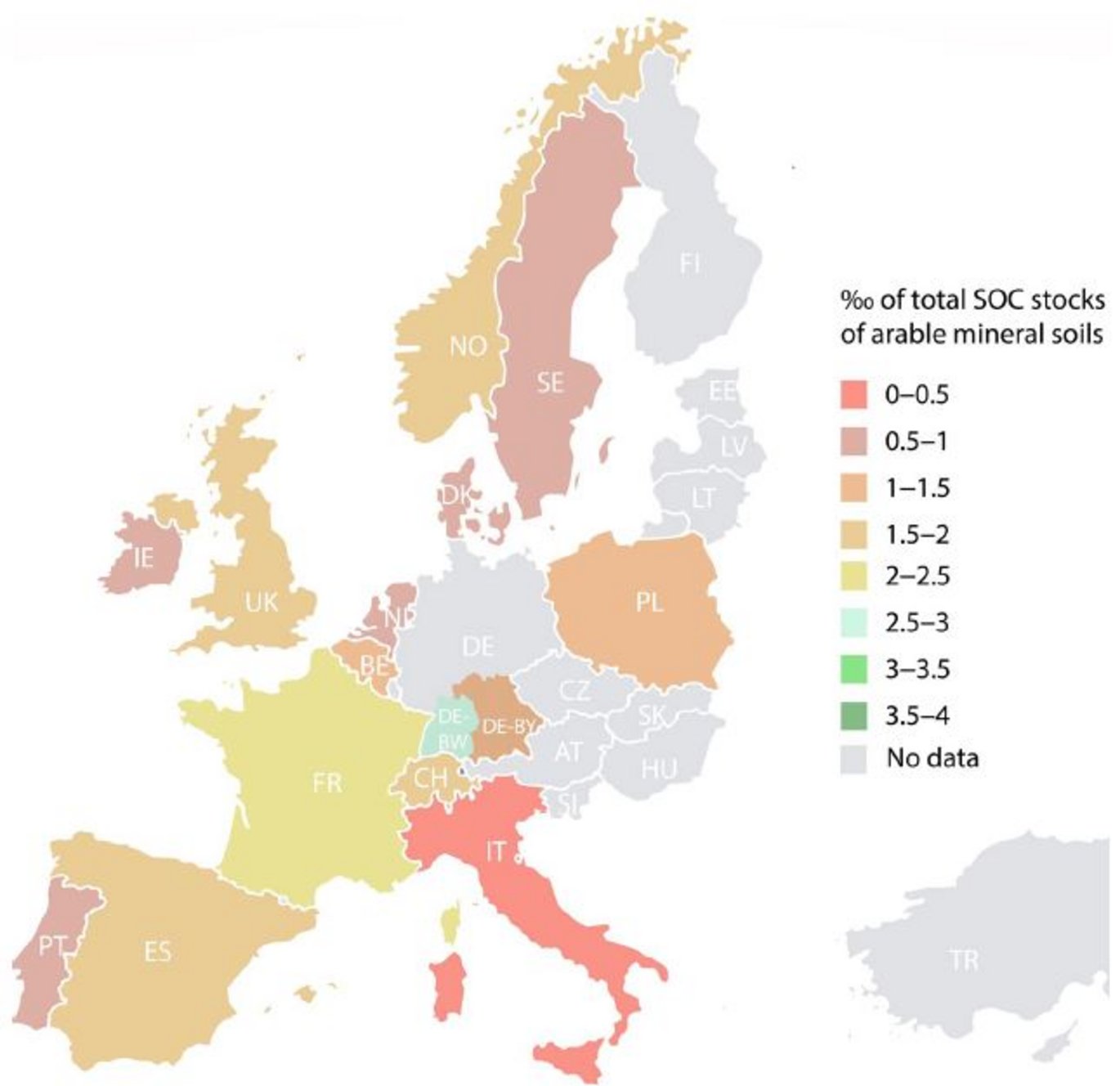Achievable agricultural soil carbon sequestration across Europe from country-specific estimates
Results from analysis suggest that country-specific knowledge and soil carbon sequestration (SCS) estimates together with improved data sharing and harmonization are crucial to better quantify the role of soils in offsetting anthropogenic GHG emissions at global level.

To meet the Paris Agreement goal of limiting global average temperatures to below 2℃, preferably to 1.5℃, compared to pre-industrial levels (UNFCCC, 2015), the EU aims to reduce 40% of its domestic greenhouse gas (GHG) emissions by 2030 and become the world's first climate-neutral economy by 2050 (‘Green Deal’) (EC, 2019). Today, 11% of total European GHG emissions derive from agriculture and measures to reduce and offset these emissions are urgently required to meet climate mitigation targets (EU NIR, 2021). The role of soils in the global carbon cycle and the importance of reducing GHG emissions from agriculture has been increasingly acknowledged. Soils can act either as source or sink of CO2 depending on land use and management. In the last two decades, more research has been focused on what certain agricultural practices (e.g. cover crops, residue management, land use changes), might contribute to increase SOC stocks and help removing CO2 from the atmosphere as effective climate mitigation measures.
The role of soils in the global carbon cycle and in reducing GHG emissions from agriculture has been increasingly acknowledged. The ‘4 per 1000’ (4p1000) initiative has become a prominent action plan for climate change mitigation through an annual increase in soil organic carbon (SOC) stocks by 0.4%, (i.e. 4‰ per year). However, the feasibility of the 4p1000 scenario and, more generally, the capacity of individual countries to implement soil carbon sequestration (SCS) measures remain highly uncertain. Researchers have evaluated country-specific SCS potentials of agricultural land for 24 countries in Europe. Based on a detailed survey of available literature, the estimation is that between 0.1% and 27% of the agricultural greenhouse gas (GHG) emissions can potentially be compensated by SCS annually within the next decades. Measures varied widely across countries, indicating differences in country-specific environmental conditions and agricultural practices. None of the countries' SCS potential reached the aspirational goal of the 4p1000 initiative, suggesting that in order to achieve this goal, a wider range of measures and implementation pathways need to be explored. Yet, SCS potentials exceeded those from previous pan-European modelling scenarios, underpinning the general need to include national/regional knowledge and expertise to improve estimates of SCS potentials. The complexity of the chosen SCS measurement approaches between countries ranked from tier 1 to tier 3 and included the effect of different controlling factors, suggesting that methodological improvements and standardization of SCS accounting are urgently required.
It is stated in the article that standardization should include the assessment of key controlling factors such as realistic areas, technical and practical feasibility, trade-offs with other GHG and climate change. The analysis suggests that country-specific knowledge and SCS estimates together with improved data sharing and harmonization are crucial to better quantify the role of soils in offsetting anthropogenic GHG emissions at global level.
Read the full article, click here.
Authors of full article and how to cite:
Rodrigues, L., Hardy, B., Huyghebeart, B., Fohrafellner, J., Fornara, D., Barančíková, G., Bárcena, T. G., De Boever, M., Di Bene, C., Feizienė, D., Kätterer, T., Laszlo, P., O’Sullivan, L., Seitz, D., & Leifeld, J. (2021). Achievable agricultural soil carbon sequestration across Europe from country-specific estimates. Global Change Biology, 27, 6363–6380.
Additional supporting information may be found in the online version of the article at the publisher’s website: https://doi.org/10.1111/gcb.15897